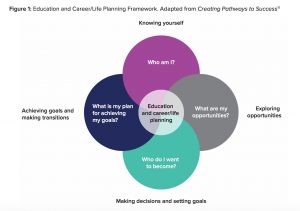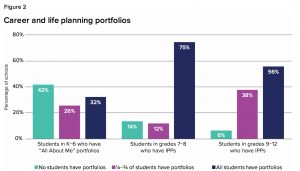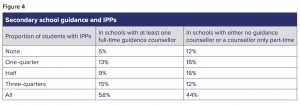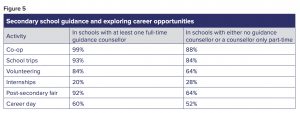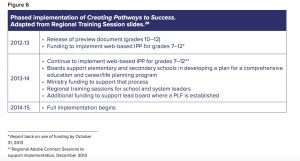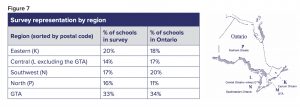Multiple paths; multiple policies; multiple challenges
In response to questions about the requirements of Creating Pathways to
Success:
- 15% of elementary and 39% of secondary schools report they have career and life planning committees
- 34% of elementary and 56% of secondary schools report that every student has an education and career/life planning portfolio
- 23% of elementary and 40% of secondary schools report professional development on career and life planning is available to their teachers
Across Canada, provinces and territories are implementing strategies to ensure that young people are prepared for futures that may no longer include one clear career or life path (see Appendix).
In Ontario, the government has committed to developing “an integrated strategy to help the province’s current and future workforce adapt to the demands of a technology-driven knowledge economy…by bridging the worlds of skills development, education and training.”1 But an examination of current strategies shows substantial gaps in both integration and implementation.
While Ontario has aspirations for a comprehensive careers’ strategy in education, results from People for Education’s 2016-17 Ontario School Survey show problems, particularly in the implementation of the kindergarten to grade 12 education and career/life planning policy.
The province’s careers’ strategy has a number of components, including revisions to curriculum, a compulsory grade 10 course in Career Studies, 40 hours of community involvement,2 and Creating Pathways to Success: An Education and Career/Life Planning Program for Ontario Schools. The Creating Pathways policy, introduced in 2013, is intended to support students as they transition through school and plan for their futures. It includes a number of mandatory components:
- career and life planning committees in every school,
- portfolios for every student from kindergarten to grade 12, and
- professional development for teachers.
These were intended to be implemented by 2015,3 but in their responses to the 2016–17 Ontario School Survey, principals reported substantial challenges in implementing the policy.
Ontario is not unique in its desire for an integrated and comprehensive approach to supporting children, young people, and adults as they take a potentially non-linear path through life. Across Canada, rapid technological, economic, and social change has prompted public education systems to adapt their models for career and life planning.
Many newly developed programs aim to be comprehensive, focusing not just on potential career paths, but also on teaching students to become lifelong learners, developing marketable skills for changing provincial economies, and providing opportunities to explore their interests and future aspirations. Most of these programs also integrate the development of life skills. These kinds of integrated frameworks put an emphasis on the idea of a career as something that evolves and changes, rather than one particular “path.” For example, Saskatchewan’s Career Education curriculum functions with the aim of exploring the connections between life and work, and developing competencies that help students achieve both life and career goals.4
Where provinces differ is in how they offer these programs. Some provinces have a single course—which may or may not be mandatory for graduation—in which students explore their possible life and/or career paths. Other provinces have created an integrated, multi-level curriculum that spans many grades. These curricula may have a different theme or focus each year, or they might be arranged with a single theme explored over a cluster of grades. Provinces also differ in the amount of career education students are expected to complete each year. For example, in Ontario, career education is to be covered throughout the curriculum and in all grades from kindergarten to grade 12,5 including the mandatory half-credit course in grade 10. On the other hand, Manitoba offers four career education courses from grades 9 to 12, none of which are mandatory.6
Though many provinces incorporate well-being in their career education frameworks, only Alberta has built its program on a framework of health and well-being.7 The goal of Alberta’s Career and Life Management (CALM) program is to “enable students to make well-informed, considered decisions and choices in all aspects of their lives, and to develop behaviours and attitudes that contribute to the well-being and respect of self and others, now and in the future.”8 To help students achieve this goal, CALM focuses on determinants of health and how career and career choice fit into one’s overall health and well-being.
The four questions in the framework:
- Who am I?
- What are my opportunities?
- Who do I want to become? and
- What is my plan for achieving my goals?
are relevant at any age or stage of development; only context and emphasis change as a student progresses through school, from Kindergarten to Grade 12.
Creating Pathways to Success, p. 12
Ontario’s Creating Pathways to Success policy acknowledges that today’s students are facing very different challenges than those of the previous generation. For this reason, the policy does not define “career,” or “career/life” in the traditional sense of a person’s occupation, but in a broader way, as the “sum of a person’s experiences in a variety of roles throughout life.”9
The ultimate vision of the policy is that every student in Ontario will leave secondary school with both a “clear plan for his or her preliminary postsecondary destination” and an understanding that this plan needs to be adaptable, so that it can be responsive to changes in their own goals and interests, as well as changes in the world around them.
The goals of the policy are to:
- allow students to develop the skills and knowledge necessary to be able to make education, career, and life choices;
- provide students with opportunities for learning in and out of the classroom; and
- to engage parents and the broader community in the development, implementation and evaluation of the program.
The policy, which replaces the Choices into Action policy introduced in 1999,10 envisions an ongoing learning process in four “areas of learning:” Knowing Yourself; Exploring Opportunities; Making Decisions and Setting Goals; and Achieving Goals and Making Transitions (see Figure 1).
Taking a comprehensive approach
Unlike the Guidance and Career Education curriculum, which includes Career Studies and Learning Strategies, the education and career/life planning program is not intended to be confined to a single curriculum. It was envisioned as a whole-school initiative to be integrated into all curricula, and supported by a range of individual and school-wide activities, as well as engagement with the community. The policy states that, “In order for the program to succeed, students, teachers and guidance teachers/counsellors, administrators, parents, and community partners need to be familiar with the framework.”12
Part of the philosophy of Creating Pathways to Success is that it puts “students at the centre of their own learning.”13 It is intended to support students’ capacity for self-discovery and to build their self-knowledge. The policy provides a strategy for teachers to support students as they develop this self-awareness, and help them reflect on their goals as they move through the education system.
To that end, student portfolios are an important element of the program. All students from kindergarten to grade 12 are required to keep regularly reviewed and updated portfolios. The portfolios track student learning, guide school transitions and course selection, and allow students to reflect on their career and life goals.14
We are just at the very initial stages with the All About Me and IPPs. There have been software glitches and staff have been asked to use other techniques—not where we would like to be either at the school nor board level.
Elementary school, Algonquin and Lakeshore CDSB
From kindergarten to grade 6, students are to document their learning in an “All About Me” portfolio. The students are supposed to use four inquiry questions—Who am I? What are my opportunities? Who do I want to become? What are my goals?—to reflect on what they are learning and decide what to include in their portfolios. The portfolios—which can be online or paper-based—are meant to contain evidence of their learning in a format that is age appropriate (e.g. drawings, self-reflections, handouts). They are to be reviewed at least twice a year with the student, teacher, and parents.
The “All About Me” portfolio follows students through grade 6. At that time, they are to summarize and transition the key information into an online Individual Pathways Plan (IPP). The IPP starts in grade 7, and is to be used to support students in the transition to secondary school, including course choices for Grade 9.
From grades 7 to 12, students keep track of their learning through the IPP. While the “All About Me” portfolio focuses more on self-knowledge, the IPP is intended to be the primary planning tool for choosing courses and exploring potential post-secondary destinations. According to the policy, the IPP allows students to take control of their learning and plan for their futures.
Implementation of portfolios inconsistent
The policy requires every student to have an “All About Me” portfolio or an Individual Pathways Plan (IPP), but our survey results show significant gaps in the implementation.
In comments from the surveys, principals pointed to a number of barriers that appear to have delayed implementation of the portfolios, including:
- a lack of provincial and administrative guidance as to what is expected in using the portfolios.
- technical issues with websites or software used for online portfolios.
…originally implemented digital portfolio was not easy to manage and no supports [were] available. In the end, implementation failed.
Elementary school, Upper Canada DSB
Higher implementation in schools
with grades 7 and 8
There is more consistent use of portfolios in elementary schools that include grades 7 and 8. According to comments from the survey, there may be a number of reasons for this, chief among them that the IPPs are seen as useful for supporting transitions to secondary school, including course selection. There also may have been more professional development available to support grade 7 and 8 teachers, and some boards appear to have communicated that “All About Me” portfolios were optional and IPPs mandatory.
It is also possible that grade 7 and 8 teachers were already in the habit of using the Annual Education Plans because they were first made mandatory for all students in grades 7 to 12 in the 1999 Choices into Action policy.15
Every elementary and secondary school will establish an Education and Career/Life Planning Program Advisory Committee to coordinate the development, implementation, and evaluation of the school’s program.
Creating Pathways to Success, p. 37
The policy also mandates committees in every school to act as
supports and catalysts for comprehensive career and life planning strategies. These Education and Career/Life Planning Program Advisory Committees must include administrators, teachers, students, parents, and members of the community. In secondary schools, the committee must also include guidance staff.16
The committees are responsible for coordinating the development, implementation, and evaluation of the school’s education, career, and life planning program. They are intended to ensure that career and life planning is integrated into all aspects of school life, and that opportunities are provided for student engagement in the local community. Community participation on the committee is expected to promote connections with local industry, extending student opportunities for practical learning experiences.17
Every elementary and secondary school will establish an Education and Career/Life Planning Program Advisory Committee to coordinate the development, implementation, and evaluation of the school’s program.
Creating Pathways to Success, p. 37
Education and career/life planning committees vital to support implementation
In 2016-17, only 15% of elementary and 39% of secondary schools report having education and career/life planning committees.
Despite their key role within the education and career/life planning policy, and despite being made mandatory in the previous Choices into Action18 policy, results from People for Education’s 2016-2017 survey show that only 15% of elementary schools and 39% of secondary schools report having Education and Career/Life Planning Program Advisory Committees.
A number of principals commented that parent and community involvement in career and life programs would help to create important links for students to the world outside of the classroom. However, results from the survey show that it has been difficult for most schools to meet the policy’s membership requirements.
In the schools (15% of elementary and 39% of secondary) with
committees:
- Only 13% of elementary and 8% of secondary schools report having community members on the committee.
- Only 33% of elementary and 12% of secondary schools report their committees include parents.
More connections [are] required from industry to help give students experiential learning and to see what opportunities wait for them.
Secondary school, Toronto DSB
The data also suggest a connection between the presence of a committee and the implementation of other parts of the policy (see Figure 3).
In the elementary schools with advisory committees:
- 66% report that all K-6 students had “All About Me” portfolios, compared to only 27% in schools without an advisory committee.
- 92% of schools with grades 7 and 8 report that all grade 7 and 8 students have Individual Pathways Plans, compared to 70% in schools without an advisory committee.
- 67% offer professional development for teachers, compared to only 12% of schools without an advisory committee.
In the secondary schools with advisory committees:
- 64% report that all students have Individual Pathways Plans, compared to 51% in schools without an advisory committee.
- 64% offer professional development for teachers, compared to only 25% of schools without committees.
Students in elementary and secondary school are expected to review their portfolios with staff (and parents, if possible), at least twice a year. These reviews are intended to provide students with personalized, one-on-one support from school staff to help students understand more about their own learning, their interests, the transitions they are making, and their career plans. In secondary schools, guidance counsellors are to play a key role in developing and implementing the Creating Pathways program.19 During grades 11 and 12, semi-annual reviews of IPPs are intended to provide an opportunity for students to receive direct guidance from school personnel on crucial course selections and post-secondary planning.20
Guidance counsellors in secondary school
Data from the 2016–17 survey confirm that in the majority (80%) of secondary schools, the guidance counsellor is the primary staff member responsible for supporting students in creating and reviewing Individual Pathways Plans. In the secondary schools that report having an Education and Career/Life Planning Advisory Committee, the vast majority (97%) include guidance counsellors. Results from the survey suggest a relationship between the presence of a full-time guidance counsellor and the proportion of students with IPPs (see Figure 4).
Guidance counsellors are identified as a key part of the post-secondary planning process, but data from the 2016–17 surveys show that 16% of secondary schools do not have a full-time guidance counsellor. Boards receive funding for guidance counsellors in secondary schools at a rate of one counsellor for every 385 students.21 This year’s survey indicates that the average ratio per school of students to guidance counsellors is 380 to 1, but in 10% of schools, that ratio is as high as 600 to 1.
Guidance counsellors in elementary schools
One of the purposes of the education and career/life planning strategy is to support students as they make transitions – from grade to grade, from elementary to secondary school, and from secondary school to their post-secondary destinations.
There is evidence that the transition from elementary to secondary school is particularly challenging for many students.22 To support this transition, the Creating Pathways policy envisions a shift in students’ portfolios as they move from grade 6 to grade 7. Students are supposed to summarize and transfer what they’ve learned from their “All About Me” portfolios into the Individual Pathways Plans they will keep from grade 7 to grade 12. The policy requires school boards to ensure that processes and supports are available to support students as they make this shift, from what can be either a paper-based or online portfolio to a strictly web-based one, and from a plan that is focused on self-knowledge to one that is more focused on future plans.
Creating Pathways does not specifically identify guidance counsellors as supports for IPPs in grades 7 and 8, or for students making these transitions. But in the 2016–17 Ontario School Survey, a number of principals commented that the lack of guidance staff has contributed to the difficulty of implementing the policy. School boards receive funding for guidance counsellors in elementary school at a rate of one counsellor for every 5,000 elementary students.
Only 17% of elementary schools have guidance counsellors, and the majority are part-time. In elementary schools that include grades 7 and 8—where the more complex IPPs are required—only 23% have guidance counsellors, the majority part-time. As a result, in 69% of schools, the classroom teacher is responsible for the development and review of the IPPs and “All About Me” portfolios.
We really need additional funding to have guidance counsellors available at the elementary level to facilitate proper life planning and transition to high school.
Elementary school, Hamilton-Wentworth DSB
Despite having 600 students in grades 7 and 8, and 900 students in total (6, 7, 8) our Guidance allocation is only 0.5. It’s not enough. We need to put our money where our mouth is and give more support to planning, guidance, and mental health.
Elementary school, Peel DSB
Our guidance counsellor is half-time and shared between two schools. It makes it difficult to follow up and support students when they are away every other day.
Elementary school, Toronto DSB
Staff have difficulty using the Creating Pathways software and have not received training for it. The model to train one teacher who provides in-service to all other teachers was not successful.
Elementary school, Upper Canada DSB
One of the goals of the Creating Pathways policy is that education and career/life planning is integrated into existing curriculum from kindergarten to grade 12. Strategies for integration include things like connecting education and career/life planning goals to overall curriculum expectations (for example, in elementary Language curriculum students are required to “reflect on and identify their strengths as listeners and speakers …”),23 or providing teacher prompts (for example, in grade 7 music, a teacher could ask students to “write a résumé highlighting your achievements as a musician. What careers related to music would best suit your interests and areas of strength?”).24 The policy also requires that all curriculum documents released in 2013 or later contain a section on education and career/life planning.
To support this integration, Creating Pathways mandates professional development for teachers on all of the aspects of the education and career/life planning program. This professional learning is seen as vital for staff to be able to effectively integrate program content into their curriculum and teaching plans. In elementary schools in particular, where classroom teachers (working, for the most part, without the support of guidance counsellors), are responsible for implementing the program and developing the “All About Me” portfolios and IPPs, this professional learning could provide much-needed support.
Professional development is a mandatory component of the policy, yet only 23% of elementary schools and 40% of secondary schools report that it is provided to teachers. Among schools reporting professional development, the frequency and time allocated varies dramatically from a single session in a year, to monthly meetings on the topic.
Schools commented that the lack of access to professional development is a major roadblock to the implementation of the “All About Me” and the Individual Pathways Plan portfolios. The lack of professional development may be a factor in the uneven implementation of career and life planning programs, especially programs using new technology and software.
More training and support is needed for classroom teachers to integrate this technology into their classrooms effectively.
Elementary school, Lambton Kent DSB
Clear direction that is supported with resources and professional learning for teachers would be beneficial.
Elementary school, Thames Valley DSB
One of the objectives of Creating Pathways to Success is to give students opportunities to explore different life and career interests through practical experiences.25 Firsthand exposure to different post-secondary destinations and careers is also meant to foster a mindset of adaptability and change.26
On this year’s survey, the vast majority of secondary schools (98%) report having cooperative education, which allows students to gain work experience and participate in job shadowing while receiving course credit.27
Guidance counsellors appear to have an impact here as well. The
results suggest a relationship between having at least one full-time
guidance counsellor and having more opportunities to explore careers (see Figure 5).
Creating Pathways to Success was to be implemented in a 3-year process.29 In 2012–13, the Ministry of Education hosted regional information sessions to introduce the policy framework to approximately 2500 guidance and co-operative education teachers. The policy framework laid out a three-year implementation plan, with full implementation envisioned for the 2014–15 school year. It was supported with funding for boards to integrate online tools and provide professional development. The province also funded Creating Pathways to Success Professional Learning Communities (PLCs) in eight regions across the province.
In September 2013, the complete Creating Pathways document was released and implementation began. Boards were invited to regional training sessions to help them in developing board-level implementation plans. Also, the Ministry of Education supported the establishment of eleven PLCs across the province. These PLCs were to act as liaisons, sustain professional learning and knowledge dissemination, support the development of board implementation strategies, and develop tools and resources.
In the 2016–17 surveys, principals reported many challenges to implementation, including a labour dispute in the first two years of the policy, a lack of technology support, workload issues, and a lack of overall understanding of the policy.
Ontario has a range of policies focused on ensuring that students have the capacity, experience, supports, and skills they need to manage transitions, make plans and understand possible career paths. Creating Pathways to Success, the Specialist High Skills Major, 21st Century Learning, the Ministry of Children and Youth Services’ Stepping Up framework, and the work of the Highly Skilled Workforce Expert Panel30 all provide a range of strategies, directions and programs to support students, teachers and the education system.
Ontario is also planning to introduce a new well-being strategy31 to promote “a positive sense of self, spirit and belonging that we feel when our cognitive, emotional, social and physical needs are being met.” The goals of the well-being strategy are similar to the goals of the Creating Pathways strategy, with its aim that students become “confident, independent, and effective education and career/life planners throughout their lives.” The challenge of these multiple strategies/initiatives is in their lack of coherence and overlapping goals. They create the perception that schools are responsible for implementing an ever-increasing roster of individual programs.
People for Education recommends that the province:
- Provide a greater level of coherence in its policy and goals for students’ overall success and well-being, by:
- Using the Creating Pathways policy, portfolios, and professional development as a key anchor for the Ministry’s larger umbrella strategies, such as the upcoming Well-being Strategy, the Renewed Math Strategy, and the implementation of recommendations from Ontario’s Highly Skilled Workforce Expert Panel.
- Developing consistent language and goals to link the Creating Pathways portfolios to the Learning Skills and Work Habits on Ontario report cards.
- Using the Creating Pathways language and goals to build value for broad essential skills and competencies within classrooms, including those outlined in People for Education’s Measuring What Matters initiative.32
- Linking the compulsory 40 hours of community involvement more closely to explorations of career pathways.
- Implement the following recommendations from its Highly Skilled Workforce Expert Panel:
- Review the Guidance and Career Education curriculum to ensure that it exposes students to a variety of learning pathways and
opportunities. - Provide students from K-12 with more exposure to the science, engineering and technology fields, as a foundation for the diverse careers of this technological age.
- Provide professional development opportunities to teachers with a counselling role, to expand their knowledge of current and future labour market trends, skills requirements and emerging careers.
- Encourage school boards and partners with demonstrated capacity to design and implement experiential learning projects to collaboratively develop new ways of introducing students in the classroom to different career pathways.
- Develop an Ontario-specific skills and competencies framework, using the experience of other jurisdictions as a guide.
- Identify promising ways of teaching students competencies demanded by the evolving economy, such as problem solving, teamwork and entrepreneurial spirit, across curricular and extra-curricular learning opportunities, including through the arts, sports, math and science.
- Review the Guidance and Career Education curriculum to ensure that it exposes students to a variety of learning pathways and
- Evaluate current education policies that may include guidance counsellors, in order to rationalize Ontario’s guidance programs and create greater alignment across the policies.
- Clarify the role of both elementary and secondary school guidance counsellors in a way that recognizes both the breadth of their responsibilities and their relative scarcity in Ontario’s K-12 schools.
- Improve elementary school guidance capabilities by changing the funding formula so that per-pupil funding for guidance counsellors is provided for students in grades 7 and 8 at the same rate as it is for secondary school students.
- Explore cost-effective ways for guidance staff supports to be expanded in small town–rural areas, where they are currently lacking compared to their urban–suburban peers.
Unless cited from other sources, the statistics and quoted material in this report originate from People for Education’s 20th annual survey (2016–17) of Ontario’s elementary schools, and 17th annual survey of Ontario’s secondary schools. Surveys were mailed to principals in every publicly funded school in Ontario in the fall of 2016. Schools in French language school boards received surveys translated into French. Surveys could also be completed online in English and French.
This year we received 1,101 responses from elementary and secondary schools in 71 of Ontario’s 72 publicly funded school boards, representing 22% of the province’s publicly funded schools. Survey responses are also disaggregated to examine survey representation across provincial regions (see Figure 7). Although regional representation in this year’s survey corresponds relatively well with the regional distribution of Ontario’s schools, schools located in the North are overrepresented in the survey by five percentage points.
Data analysis and reporting
The analyses in this report are based on both descriptive and inferential statistics. The chief objective of descriptive analyses is to present numerical information in an illuminating format that is accessible to a broad public readership. All data were analyzed using SPSS statistical software.
Calculations have been rounded to the nearest whole number and may not amount to 100% in displays of disaggregated categories. The average student to staff ratio was calculated for schools that reported both the total number of students and the full-time equivalents for staff positions. All survey responses and data are kept confidential and stored in conjunction with Tri-Council recommendations for the safeguarding of data.
- The Premier’s Highly Skilled Workforce Expert Panel, Building the Workforce of Tomorrow: A Shared Responsibility (Toronto, ON: Government of Ontario, June 23, 2016), https://www.ontario.ca/page/building-workforce-tomorrow-shared-responsibility#section-0.
- Ontario Ministry of Education, Policy/Program Memorandum No. 124a, Issued under the authority of the Deputy Minister of Education (Toronto, ON: Government of Ontario, accessed February 22, 2017), http://www.edu.gov.on.ca/extra/eng/ppm/124a.html.
- Ontario Ministry of Education, “Phased Implementation,” Creating Pathways to Success Regional Training Sessions (Toronto, ON: Government of Ontario, 2013), http://www.edugains.ca/resourcesECLP/ProfLearningFacilitator/CPS_TrainingPowerpoint.pdf.
- Saskatchewan Ministry of Education, Career Education 6 (Regina, SK: Government of Saskatchewan, 2008), https://www.edonline.sk.ca/bbcswebdav/library/curricula/English/Career_Education/Career_Education_6_2008.pdf.
- Ontario Ministry of Education, Creating Pathways to Success: An Education and Career/Life Planning Program for Ontario Schools (Toronto, ON: Queen’s Printer for Ontario, 2013), http://www.edu.gov.on.ca/eng/document/policy/cps/creatingpathwayssuccess.pdf.
- Manitoba Education, Citizenship and Youth, Grade 9 Career Development: Life/Work Exploration (Winnipeg, MB: Government of Manitoba, 2007), http://www.edu.gov.mb.ca/k12/cur/cardev/gr9_found/full_doc.pdf.
- Alberta Learning, Career and Life Management: Guide to Implementation (Edmonton, AB: Government of Alberta, 2002), https://education.alberta.ca/media/1477141/calmgi.pdf.
- Ibid., 1.
- Ontario Ministry of Education, Creating Pathways to Success, 6.
- Ontario Ministry of Education and Training, Choices into Action: Guidance and Career Education Program Policy for Ontario Elementary and Secondary Schools, 1999, (Toronto, ON: Queen’s Printer for Ontario, 1999) http://www.ycdsb.ca/programs-services/SCP/documents/choicee.pdf.
- Ontario Ministry of Education, Creating Pathways to Success, 13.
- Ibid., 13.
- Ibid., 7.
- Ibid., 17-9.
- Ontario Ministry of Education and Training, Choices into Action, 16.
- Ontario Ministry of Education, Creating Pathways to Success, 41.
- Ibid., 41.
- Ontario Ministry of Education and Training, Choices into Action, 23.
- Ontario Ministry of Education, Creating Pathways to Success, 28.
- Daniel Hamlin, David Hagen Cameron, and Elyse Watkins, Ontario’s Guidance Counsellors: Spread Thinly in an Environment of Growing Expectations (Toronto, ON: People for Education, March 7, 2016), http://www.peopleforeducation.ca/wp-content/uploads/2016/03/P4E-Guidance-2016.pdf.
- Ontario Ministry of Education, Education Funding: Technical Paper (Toronto, ON: Government of Ontario, 2016), http://www.edu.gov.on.ca/eng/funding/1617/2016_technical_paper_en.pdf, 23.
- Hamlin, Hagen Cameron, and Watkins, Ontario’s Guidance Counsellors.
- Ontario Ministry of Education, Creating Pathways to Success, 27.
- Ibid., 28.
- Ibid., 3.
- Ibid., 6.
- Ontario Ministry of Education, Cooperative Education and Other Forms of Experiential Learning (Toronto, ON: Queen’s Printer for Ontario, 2000), http://www.edu.gov.on.ca/eng/document/curricul/secondary/coop/cooped.pdf.
- Ibid.
- Ontario Ministry of Education, “Phased Implementation.”
- Ontario Ministry of Child and Youth Services, Stepping Up Annual Report 2015 (Toronto, ON: Government of Ontario, 2015), http://www.children.gov.on.ca/htdocs/English/professionals/steppingup/steppingup2015/contents.aspx. Ontario Ministry of Education, 21st Century Competencies: Foundation Document for Discussion (Toronto, ON: Queen’s Printer for Ontario, 2015), http://www.edugains.ca/resources21CL/About21stCentury/21CL_21stCenturyCompetencies.pdf. Ontario Ministry of Education, Creating Pathways to Success. Ontario Ministry of Education, Specialist High Skills Major (Toronto, ON: Government of Ontario, accessed February 22, 2017), http://www.edu.gov.on.ca/morestudentsuccess/SHSM.html. The Premier’s Highly Skilled Workforce Expert Panel, Building the Workforce of Tomorrow.
- Ontario Ministry of Education, Ontario’s Well-Being Strategy for Education: Discussion Document (Toronto, ON: Queen’s Printer for Ontario, 2016), http://www.edu.gov.on.ca/eng/about/WBDiscussionDocument.pdf.
- “Measuring What Matters,” People for Education, accessed February 22, 2017, http://peopleforeducation.ca/measuring-what-matters/.
- Alberta Education, Career and Technology Studies: Program Philosophy and Rationale (Edmonton, AB: Government of Alberta, 2009), https://education.alberta.ca/media/482254/philosophy.pdf.
- Alberta Education, CTF Program of Studies (Edmonton, AB: Government of Alberta, 2016), https://education.alberta.ca/media/3272955/ctf-program-of-studies-revised-sept-1.pdf.
- Alberta Education, Career and Life Management (Edmonton, AB: Government of Alberta, 2002), https://education.alberta.ca/media/160199/calm.pdf.
- British Columbia Ministry of Education, Update on Career Education K-12 (Vancouver, BC: Government of British Columbia, 2015), https://curriculum.gov.bc.ca/sites/curriculum.gov.bc.ca/files/pdf/career-education.pdf.
- British Columbia Ministry of Education, Planning 10: Integrated Resource Package 2007 (Vancouver, BC: Government of British Columbia, 2007), http://www2.gov.bc.ca/assets/gov/education/kindergarten-to-grade-12/teach/pdfs/curriculum/healthcareer/2007planning10.pdf.
- Manitoba Education, Citizenship and Youth, Grade 9 Career Development: Life/Work Exploration (Winnipeg, MB: Government of Manitoba, 2007), http://www.edu.gov.mb.ca/k12/cur/cardev/gr9_found/full_doc.pdf.
- New Brunswick Department of Education, Personal Development and Career Planning 6-12, (Fredericton, NB: Government of New Brunswick, 2000), http://www2.gnb.ca/content/dam/gnb/Departments/ed/pdf/K12/curric/Guidance/PersonalDevelopmentCareerPlanning6-12.pdf.
- New Brunswick Department of Education, Career Exploration 110 (Fredericton, NB: Government of New Brunswick, 2005), http://www2.gnb.ca/content/dam/gnb/Departments/ed/pdf/K12/curric/Coop/CareerExploration110.pdf.
- Newfoundland and Labrador Department of Education, Career Development 2201 Curriculum Guide (St. John’s, NL: Government of Newfoundland and Labrador, 2010), http://www.ed.gov.nl.ca/edu/k12/curriculum/guides/careered/careered/cd2201_full.pdf.
- Nova Scotia Department of Education and Early Childhood Development, Life/Work Transitions Curriculum (Halifax, NS: Government of Nova Scotia, 1999), http://www.ednet.ns.ca/files/curriculum/LifeWorkTransitions10.pdf.
- Nova Scotia Department of Education and Early Childhood Development, The 3Rs: Renew, Refocus, Rebuild—Nova Scotia’s Action Plan for Education (Halifax, NS: Government of Nova Scotia, 2015), https://www.ednet.ns.ca/sites/default/files/docs/educationactionplan2015en.pdf.
- Ontario Ministry of Education, Creating Pathways to Success.
- Ontario Ministry of Education, The Ontario Curriculum Grades 9 and 10: Guidance and Career Education (Toronto, ON: Queen’s Printer for Ontario, 2006), http://www.edu.gov.on.ca/eng/curriculum/secondary/guidance910currb.pdf.
- Prince Edward Island Department of Education and Early Childhood Development, “Career Explorations and Opportunities,” 2015-2016
Senior High Program of Studies and List of Authorized Materials (Charlottetown, PE: Government of Prince Edward Island, 2015), http://www.edu.pe.ca/threeoaks/general/resources/registration/program_of_studies.pdf, 26. - Québec Ministry of Education, “Chapter 2: Broad Areas of Learning,” Québec Education Program: Secondary School Education, Cycle One (Québec, QC: Bibliothèque nationale du Québec, 2004), http://www1.education.gouv.qc.ca/sections/programmeFormation/secondaire1/pdf/chapter2.pdf, 20-9. Québec Ministry of Education, “Chapter 2: Broad Areas of Learning,” Québec Education Program: Secondary School Education, Cycle Two (Québec, QC: Bibliothèque nationale du Québec, 2007), http://www1.education.gouv.qc.ca/sections/programmeFormation/secondaire2/medias/en/2_QEP_Chap02.pdf. Québec Ministry of Education, “Chapter 3: Broad Areas of Learning,” Québec Education Program: Preschool Education and Elementary Education (Québec, QC: Bibliothèque nationale du Québec, 2001), http://www1.education.gouv.qc.ca/sections/programmeFormation/primaire/pdf/educprg2001/educprg2001-030.pdf 41-50.
- Saskatchewan Ministry of Education, Career Education 6.
Alberta Education. Career and Life Management. Edmonton, AB: Government of Alberta, 2002. https://education.alberta.ca/media/160199/calm.pdf.
Alberta Learning. Career and Life Management: Guide to Implementation. Edmonton, AB: Government of Alberta, 2002. https://education.alberta.ca/media/1477141/calmgi.pdf.
Alberta Education. Career and Technology Studies: Program Philosophy and Rationale. Edmonton, AB: Government of Alberta, 2009. https://education.alberta.ca/media/482254/philosophy.pdf.
Alberta Education. CTF Program of Studies. Edmonton, AB: Government of Alberta, 2016. https://education.alberta.ca/media/3272955/ctf-program-of-studies-revised-sept-1.pdf.
British Columbia Ministry of Education. Planning 10: Integrated Resource Package 2007. Vancouver, BC: Government of British Columbia, 2007. http://www2.gov.bc.ca/assets/gov/education/kindergarten-to-grade-12/teach/pdfs/curriculum/healthcareer/2007planning10.pdf.
British Columbia Ministry of Education. Update on Career Education K-12. Vancouver, BC: Government of British Columbia, 2015. https://curriculum.gov.bc.ca/sites/curriculum.gov.bc.ca/files/pdf/career-education.pdf.
Hamlin, Daniel, David Hagen Cameron, and Elyse Watkins. Ontario’s Guidance Counsellors: Spread Thinly in an Environment of Growing Expectations. Toronto, ON: People for Education, March 7, 2016. http://www.peopleforeducation.ca/wp-content/uploads/2016/03/P4E-Guidance-2016.pdf.
Manitoba Education, Citizenship and Youth. Grade 9 Career Development: Life/Work Exploration. Winnipeg, MB: Government of Manitoba, 2007. http://www.edu.gov.mb.ca/k12/cur/cardev/gr9_found/full_doc.pdf.
“Measuring What Matters.” People for Education. Accessed February 22, 2017. http://peopleforeducation.ca/measuring-what-matters/.
New Brunswick Department of Education. Career Exploration 110. Fredericton, NB: Government of New Brunswick, 2005. http://www2.gnb.ca/content/dam/gnb/Departments/ed/pdf/K12/curric/Coop/CareerExploration110.pdf.
New Brunswick Department of Education. Personal Development and Career Planning 6-12. Fredericton, NB: Government of New Brunswick, 2000. http://www2.gnb.ca/content/dam/gnb/Departments/ed/pdf/K12/curric/Guidance/PersonalDevelopmentCareerPlanning6-12.pdf.
Newfoundland and Labrador Department of Education. Career Development 2201 Curriculum Guide. St. John’s, NL: Government of Newfoundland and Labrador, 2010. http://www.ed.gov.nl.ca/edu/k12/curriculum/guides/careered/careered/cd2201_full.pdf.
Nova Scotia Department of Education and Early Childhood Development. Life/Work Transitions Curriculum. Halifax, NS: Government of Nova Scotia, 1999. http://www.ednet.ns.ca/files/curriculum/LifeWorkTransitions10.pdf.
Nova Scotia Department of Education and Early Childhood Development. The 3Rs: Renew, Refocus, Rebuild—Nova Scotia’s Action Plan for Education. Halifax, NS: Government of Nova Scotia, 2015. https://www.ednet.ns.ca/sites/default/files/docs/educationactionplan2015en.pdf.
Ontario Ministry of Child and Youth Services. Stepping Up Annual Report 2015. Toronto, ON: Government of Ontario, 2015. http://www.children.gov.on.ca/htdocs/English/professionals/steppingup/steppingup2015/contents.aspx.
Ontario Ministry of Education. 21st Century Competencies: Foundation Document for Discussion. Toronto, ON: Queen’s Printer for Ontario, 2015. http://www.edugains.ca/resources21CL/About21stCentury/21CL_21stCenturyCompetencies.pdf.
Ontario Ministry of Education. Cooperative Education and Other Forms of Experiential Learning. Toronto, ON: Queen’s Printer for Ontario, 2000. http://www.edu.gov.on.ca/eng/document/curricul/secondary/coop/cooped.pdf.
Ontario Ministry of Education. Creating Pathways to Success: An Education and Career/Life Planning Program for Ontario Schools. Toronto, ON: Queen’s Printer for Ontario, 2013. http://www.edu.gov.on.ca/eng/document/policy/cps/creatingpathwayssuccess.pdf.
Ontario Ministry of Education. Education Funding: Technical Paper. Toronto, ON: Government of Ontario, 2016. http://www.edu.gov.on.ca/eng/funding/1617/2016_technical_paper_en.pdf.
Ontario Ministry of Education. Ontario’s Well-Being Strategy for Education: Discussion Document. Toronto, ON: Queen’s Printer for Ontario, 2016. http://www.edu.gov.on.ca/eng/about/WBDiscussionDocument.pdf.
Ontario Ministry of Education. “Phased Implementation.” Creating Pathways to Success Regional Training Sessions. Toronto, ON: Government of Ontario, 2013. Microsoft PowerPoint slides. http://www.edugains.ca/resourcesECLP/ProfLearningFacilitator/CPS_TrainingPowerpoint.pdf.
Ontario Ministry of Education. Policy/Program Memorandum No. 124a, Issued under the authority of the Deputy Minister of Education. Toronto, ON: Government of Ontario, accessed February 22, 2017. http://www.edu.gov.on.ca/extra/eng/ppm/124a.html.
Ontario Ministry of Education. Specialist High Skills Major. Toronto, ON: Government of Ontario, accessed February 22, 2017. http://www.edu.gov.on.ca/morestudentsuccess/SHSM.html.
Ontario Ministry of Education. The Ontario Curriculum Grades 9 and 10: Guidance and Career Education. Toronto, ON: Queen’s Printer for Ontario, 2006. http://www.edu.gov.on.ca/eng/curriculum/secondary/guidance910currb.pdf.
Ontario Ministry of Education and Training. Choices into Action: Guidance and Career Education Program Policy for Ontario Elementary and Secondary Schools, 1999. Toronto, ON: Queen’s Printer for Ontario, 1999. http://www.ycdsb.ca/programs-services/SCP/documents/choicee.pdf.
Prince Edward Island Department of Education and Early Childhood Development. “Career Explorations and Opportunities.” 2015-2016
Senior High Program of Studies and List of Authorized Materials. Charlottetown, PE: Government of Prince Edward Island, 2015. http://www.edu.pe.ca/threeoaks/general/resources/registration/program_of_studies.pdf.
Québec Ministry of Education. “Chapter 2: Broad Areas of Learning.” Québec Education Program: Secondary School Education, Cycle One. Québec, QC: Bibliothèque nationale du Québec, 2004. http://www1.education.gouv.qc.ca/sections/programmeFormation/secondaire1/pdf/chapter2.pdf.
Québec Ministry of Education. “Chapter 2: Broad Areas of Learning.” Québec Education Program: Secondary School Education, Cycle Two. Québec, QC: Bibliothèque nationale du Québec, 2007. http://www1.education.gouv.qc.ca/sections/programmeFormation/secondaire2/medias/en/2_QEP_Chap02.pdf.
Québec Ministry of Education. “Chapter 3: Broad Areas of Learning.” Québec Education Program: Preschool Education and Elementary Education. Québec, QC: Bibliothèque nationale du Québec, 2001. http://www1.education.gouv.qc.ca/sections/programmeFormation/primaire/pdf/educprg2001/educprg2001-030.pdf.
Saskatchewan Ministry of Education. Career Education 6. Regina, SK: Government of Saskatchewan, 2008. https://www.edonline.sk.ca/bbcswebdav/library/curricula/English/Career_Education/Career_Education_6_2008.pdf.
The Premier’s Highly Skilled Workforce Expert Panel. Building the Workforce of Tomorrow: A Shared Responsibility. Toronto, ON: Government of Ontario, June 23, 2016. https://www.ontario.ca/
page/building-workforce-tomorrow-shared-responsibility#section-0.

